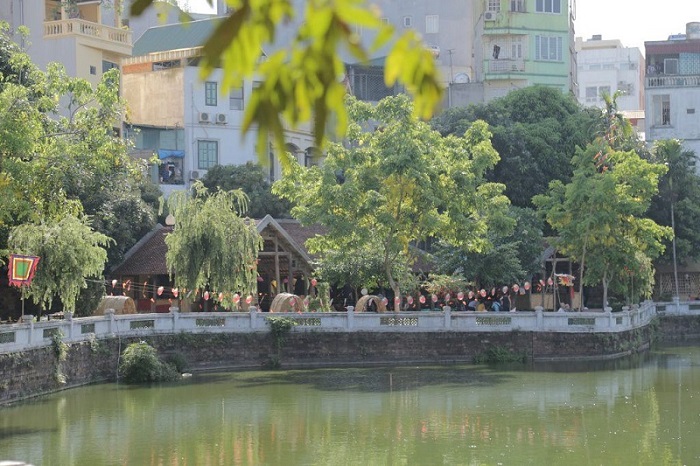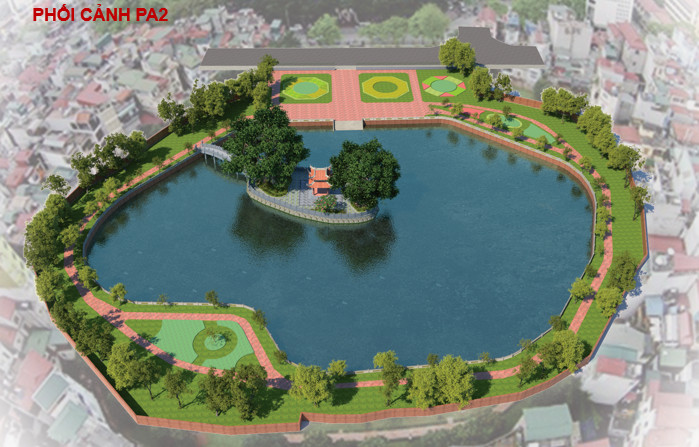Van Lake - part of Temple of Literature Complex to undergo renovation
Van Lake area is expected to be a community space for locals and visitors to enjoy cultural activities.
The Hanoi People’s Committee plans to restore and embellish Ho Van (Literature Lake), a part of the Van Mieu-Quoc Tu Giam (Temple of Literature Complex), in the capital city this month.
The Van Lake area is separated from the main structures by Quoc Tu Giam Street, it is often overlooked by visitors from the Van Mieu-Quoc Tu Giam complex.
Chairman of the Cultural Heritage Association of Vietnam Do Van Tru said the lake is an integral part of the national relic Temple of Literature so the preservation and promotion of its value will contribute to the protection of the relic.
Meeting the demand of the people
| The space of Ho Van Lake. Photo: Hovanmieu.vn |
Located in Dong Da District, Hanoi, the Ho Van area covers 11,932 square meters, of which 7,778 square meters is the lake water surface and the rest is the garden surface. In the middle of the lake, there is the Kim Chau Mound, which is a small islet in Ho Van with an area of more than 383 square meters. A shrine is built on Ho Van used to be an important part of the Temple of Literature, the first university of Vietnam, where students and intellectuals came to meet and exchange knowledge about literature and poetry.
In the 1940s, a road was built, separating the lake from the Temple of Literature complex. The place was revamped in 2016 and cultural activities have been held here occasionally such as exhibitions, Spring Calligraphy Festival, and book festivals.
Therefore, the restoration of the Ho Van area is welcome by many people and experts. The area will be renovated into a community place where people come to enjoy the scenery and recite poetry like in the old days, according to Architect Hoang Dao Kinh. Meanwhile, Nguyen Van Huy, Deputy Director of the Center for Research, Support and Development of Culture, said to The Hanoi Times that when the Ho Van cultural space was created, people living there would be the first to benefit.
“The residents not only enjoy a community cultural space but also are able to offer and earn income from tourist services. In addition, visitors to the Temple of Literature not only learn about the history of the Pavilion of the Constellation of Literature, the 82 steles of the doctorates, among other relics but also experience the cultural activities taking place in Ho Van area,” he said.
In order to revive Ho Van, Hanoi’s authorities need to think about cultural and educational activities associated with relics, according to Tru. “Cultural activities should be paid more attention and diversified to promote their value and attract more visitors,” he said.
| The project of Ho Van restoration is expected to be completed by the end of 2021. Photo: The Hanoi Times |
Greenspace
Under the project, Kim Chau Mound will be embellished and the shrine will be restored. Meanwhile, the garden area will also be renovated with new green stone tile and added more plants.
After completion, there will be a series of cultural activities held here to make it a cultural space for both residents and tourists, according to the Director of Hanoi Department of Culture and Sports, Tran The Cuong.
Hanoi is intensifying activities to foster local cultural industries to become a creative city so that the restoration of Ho Van space is in line with such policy, thanks to its good location and unique historical and cultural values, according to fine arts researcher Tran Hau Yen. “A pedestrian area could be piloted here to create favorable conditions for cultural activities,” he told The Hanoi Times.
The residents in the surrounding area of Ho Van are also advised to change the ambiance with new products and services to promote the value of the relic and help turn the neighborhood into a cultural zone.












